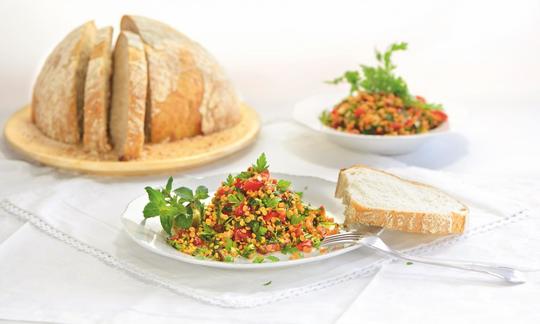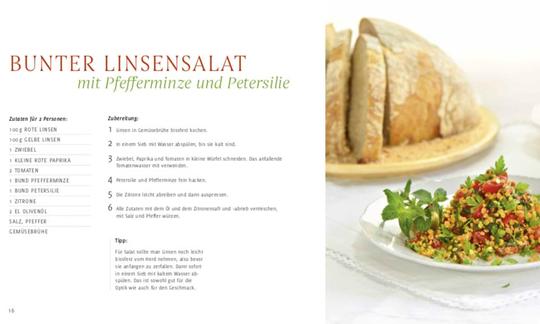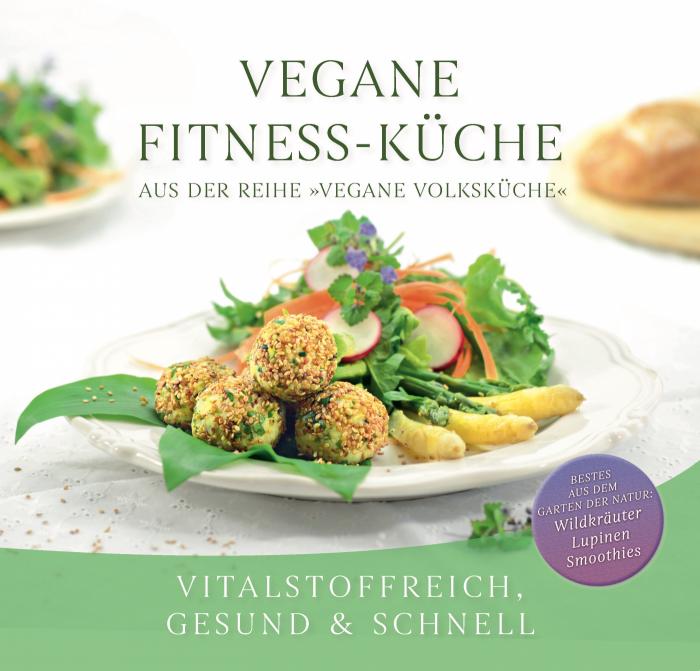Colorful lentil salad with peppermint and parsley
vegan
Ingredients (for servings, )
| 7 ⅓ oz | Lentils (Erve, kitchen lentil), raw |
| 400 ml | Vegetable broth without added salt (organic?) (14 oz) |
| 1 | Onions, raw (organic?) (3.9 oz) |
| 1 | Chili peppers, red, raw (organic?) (0.18 oz) |
| 2 | Tomatoes, raw (organic?) (8.6 oz) |
| 1 bunch | Peppermint, fresh (raw, organic?) (0.70 oz) |
| 1 bunch | Parsley, fresh, raw (leaf parsley, parsley) (1.1 oz) |
| 1 | Lemons, raw (limes, organic?) (2.0 oz) |
| 1 tbsp | Olive oil (cold pressed, raw?, organic?) (0.47 oz) |
| 1 dash | Table salt (table salt, raw?, organic?) (0.01 oz) |
| 1 dash | Black pepper (organic?, raw?) (0.00 oz) |
Equipment
- grater
- stove
- citrus juicer (lemon squeezer)
- saucepan
- sieve
Type of preparation
- cook
- chop or grind
- squeeze
- season to taste
- remove the skin
- rinse with cold water
- grate (shred)
- drain
Preparation
Preparing lentils
Cook the lentils in about 400 ml of vegetable stock until they are al dente (they should not fall apart). This takes about 15 minutes.
Then immediately rinse the lentils in a sieve with cold water.The original recipe uses normal vegetable stock. The lentils are also divided into two equal parts: yellow and red lentils.
While the lentils are cooking, you can proceed with the next steps.
Preparing the other ingredients
Peel the onion and cut it into small cubes together with the peppers and tomatoes. Use the remaining tomato water.
Finely chop the parsley and peppermint.
Lightly grate the lemon and then squeeze it.Finishing the salad
Mix the lentils, which have been drained with cold water and allowed to cool, with the remaining ingredients. Season with salt and pepper and serve.The original recipe uses 2 tablespoons of olive oil for 2 servings.
|
Nutritional Information per person
Convert per 100g
|
2000 kcal | |
|---|---|---|
| Energy | 525 kcal | 26.3% |
| Fat/Lipids | 12 g | 16.9% |
| Saturated Fats | 3.4 g | 16.9% |
| Carbohydrates (inc.dietary fiber) | 82 g | 30.5% |
| Sugars | 10 g | 11.3% |
| Fiber | 17 g | 67.4% |
| Protein/Albumin | 29 g | 57.4% |
| Cooking Salt (Na:136.5 mg) | 347 mg | 14.4% |
| Essential micronutrients with the highest proportions | per person | 2000 kcal | |
|---|---|---|---|
| Vit | Vitamin B9, B11 (Folate, as the active form of folic acid) | 560 µg | 280.0% |
| Vit | Vitamin K | 105 µg | 141.0% |
| Prot | Threonine (Thr, T, irreversibly transaminated) | 1.0 g | 109.0% |
| Prot | Tryptophan (Trp, W) | 0.26 g | 107.0% |
| Prot | Lysine (Lys, K, irreversibly transaminated) | 1.9 g | 102.0% |
| Min | Copper, Cu | 0.99 mg | 99.0% |
| Prot | Isoleucine (Ile, I) | 1.2 g | 96.0% |
| Vit | Vitamin C (ascorbic acid) | 75 mg | 94.0% |
| Min | Manganese, Mn | 1.9 mg | 93.0% |
| Vit | Vitamin B1 (Thiamine) | 1.0 mg | 93.0% |
Detailed Nutritional Information per Person for this Recipe
The majority of the nutritional information comes from the USDA (US Department of Agriculture). This means that the information for natural products is often incomplete or only given within broader categories, whereas in most cases products made from these have more complete information displayed.
If we take flaxseed, for example, the important essential amino acid ALA (omega-3) is only included in an overarching category whereas for flaxseed oil ALA is listed specifically. In time, we will be able to change this, but it will require a lot of work. An “i” appears behind ingredients that have been adjusted and an explanation appears when you hover over this symbol.
For Erb Muesli, the original calculations resulted in 48 % of the daily requirement of ALA — but with the correction, we see that the muesli actually covers >100 % of the necessary recommendation for the omega-3 fatty acid ALA. Our goal is to eventually be able to compare the nutritional value of our recipes with those that are used in conventional western lifestyles.
| Essential fatty acids | per person | 2000 kcal |
|---|---|---|
| Alpha-Linolenic acid; ALA; 18:3 omega-3 | 0.26 g | 13.0% |
| Linoleic acid; LA; 18:2 omega-6 | 1.3 g | 13.0% |
| Essential amino acids | per person | 2000 kcal |
|---|---|---|
| Threonine (Thr, T, irreversibly transaminated) | 1.0 g | 109.0% |
| Tryptophan (Trp, W) | 0.26 g | 107.0% |
| Lysine (Lys, K, irreversibly transaminated) | 1.9 g | 102.0% |
| Isoleucine (Ile, I) | 1.2 g | 96.0% |
| Phenylalanine (Phe, F) | 1.4 g | 87.0% |
| Valin (Val, V) | 1.4 g | 85.0% |
| Leucine (Leu, L) | 2.0 g | 81.0% |
| Methionine (Met, M) | 0.25 g | 27.0% |
| Vitamins | per person | 2000 kcal |
|---|---|---|
| Vitamin B9, B11 (Folate, as the active form of folic acid) | 560 µg | 280.0% |
| Vitamin K | 105 µg | 141.0% |
| Vitamin C (ascorbic acid) | 75 mg | 94.0% |
| Vitamin B1 (Thiamine) | 1.0 mg | 93.0% |
| Vitamin B6 (pyridoxine) | 0.85 mg | 60.0% |
| Vitamin B5 (Pantothenic acid) | 2.7 mg | 46.0% |
| Vitamin A, as RAE | 338 µg | 42.0% |
| Vitamin B7 (Biotin, ex vitamin H) | 19 µg | 37.0% |
| Vitamin B3 (Niacin) | 4.4 mg | 28.0% |
| Vitamin B2 (Riboflavin) | 0.36 mg | 26.0% |
| Vitamin E, as a-TEs | 2.7 mg | 23.0% |
| Essential macroelements (macronutrients) | per person | 2000 kcal |
|---|---|---|
| Potassium, K | 1'335 mg | 67.0% |
| Phosphorus, P | 384 mg | 55.0% |
| Magnesium, Mg | 92 mg | 25.0% |
| Calcium, Ca | 137 mg | 17.0% |
| Sodium, Na | 137 mg | 17.0% |
| Essential trace elements (micronutrients) | per person | 2000 kcal |
|---|---|---|
| Copper, Cu | 0.99 mg | 99.0% |
| Manganese, Mn | 1.9 mg | 93.0% |
| Iron, Fe | 9.0 mg | 64.0% |
| Zinc, Zn | 4.0 mg | 40.0% |
| Iod, I (Jod, J) | 7.8 µg | 5.0% |
| Selenium, Se | 0.52 µg | 1.0% |
| Fluorine, F | 3.5 µg | < 0.1% |
"Vegan Fitness Cuisine - Nutrient-rich, healthy & fast" includes simple, easy-to-prepare German and Mediterranean dishes.
Since this book is written in German, a description is omitted here. If you are interested, please switch to German in the menu.
Peppermint and lemon give this colorful lentil salad with parsley and tomatoes its fresh note.
Nutrient profile: Thanks to the parsley, this dish has a very high vitamin K content. According to GDA guidelines, one portion of this recipe covers several times the average daily requirement of this vitamin, which is important for blood clotting and bone metabolism. This dish covers more than 100% of the requirement for copper, lysine, tryptophan, threonine, folic acid and vitamin C. The ratio between linoleic acid (LA) and alpha-linolenic acid (ALA) is 4:1, below the recommended maximum ratio of 5:1.
Red and yellow lentils: Due to their high-quality proteins, lentils are a very good source of plant-based protein for vegans. However, you should be aware that they contain only a relatively small amount of the essential amino acid methionine, for example, which is why combining them with rice or beans in some dishes balances things out. The different types of lentils, which are uniformly round and flat, differ not only in size but also in color. Red and yellow lentils come from India and are particularly well known from the national dish dal. Because they are peeled, they cook and fall apart more quickly. Soaking them beforehand is therefore not necessary. Because they are not peeled, they absorb the flavor of spices particularly well. In terms of taste, they differ in that the red lentils taste quite mild to sweet, while the yellow lentils are a little more bitter.
Parsley: Using fresh parsley is a great way to add some extra flavor to your dishes. Parsley is a source of flavonoids, antioxidants and vitamins, especially vitamins K, C and A, making this culinary herb suitable for more than just a garnish.
Peppermint: Fresh peppermint as a tea or seasoning is much more intense than dried peppermint. The essential oil menthol can also have a pain-relieving and cooling effect. However, its effectiveness is only weak. It gives dishes a pleasant freshness.
Prepare lentils until al dente: For the salad, lentils should be taken off the stove when they are still slightly al dente, i.e. before they start to fall apart. Then rinse immediately in a sieve with cold water. This is good for both the appearance and the taste. (Gabriele Verlag)
Oil: We have reduced the specified amount of olive oil by half. Instead of olive oil, you can also use rapeseed oil, as this has a better ratio of omega-6 (LA) to omega-3 fatty acids (ALA) than the olive oil used in the recipe. For comparison, olive oil has an LA:ALA ratio of 11-12:1, whereas the ratio of the two fatty acids in rapeseed oil is just over 2:1. Read more about this: Vegans often eat unhealthily. Avoidable nutritional errors.
Vegan vegetable stock: As an alternative to low-salt vegetable broth, you can also use a vegan vegetable stock. You can find a recipe under the following link: Vegan vegetable stock.
Depending on how concentrated it is, you will need to adjust the quantities accordingly.






